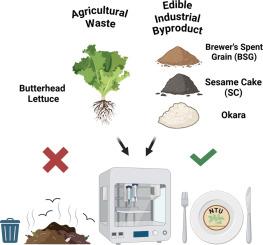食用工业和农业食品副产品在食品油墨中的流变性和3D可打印性的增值
IF 8.2
Q1 FOOD SCIENCE & TECHNOLOGY
引用次数: 0
摘要
食品生产副产品和农业剩余产生的食物浪费是一个紧迫的全球问题,导致宝贵营养物质的损失和环境挑战。本研究探索使用不同的水凝胶作为可持续载体,将这种通常被视为食物垃圾的可食用食品副产品纳入3D食品打印(3DFP)油墨中,旨在减少营养浪费,同时促进食品制造的可持续实践。研究了四种食物垃圾——芝麻饼(SC)、啤酒废粒(BSG)和莴苣(butterhead lettuce)的颗粒形态、水合能力(WHC)和密度。这些特性至关重要,因为它们决定了3DFP油墨的流变性和可打印性。流变学评估确定5% w/v热塑性塑料(TPS)凝胶为最佳基材,在挤出3DFP打印过程中具有良好的凝胶样性能、良好的结构完整性和流动性。在测试油墨中,20% w/v的BSG和生菜在剪切速率为100 1/s时的平均粘度为4016.7 mPa·s和6330.4 mPa·s,印刷性能最稳定。具有最高WHC的Okara导致油墨干燥和不稳定,即使在降低浓度时也是如此,而SC的高密度由于颗粒团聚和从凝胶相分离而导致喷嘴堵塞。这项研究展示了利用食物垃圾的纤维和蛋白质含量来制造功能性3DFP油墨的潜力。通过将零成本食品垃圾转化为可打印的食品油墨,这项研究为可持续食品制备、减少垃圾填埋和推进环保制造方法提供了创新的解决方案。本文章由计算机程序翻译,如有差异,请以英文原文为准。

Valorization of edible industrial and agricultural food byproducts for rheological properties and 3D printability in food inks
Food waste generated from food manufacturing byproducts and agricultural surplus is a pressing global concern, leading to the loss of valuable nutrients and environmental challenges. This study explores the use of different hydrogels as a sustainable carrier for incorporating this edible food by product commonly regarded as food waste into 3D food printing (3DFP) inks, aiming to reduce nutrient wastage while promoting sustainable practices in food manufacturing. Four types of food waste – okara, sesame cake (SC), brewer's spent grain (BSG), and butterhead lettuce, were investigated for their particle morphology, water hydration capacity (WHC), and tap density. These properties are crucial as they determine the rheology and printability of the 3DFP ink. Rheological evaluations identified 5 % w/v thermoplastic (TPS) gel as the optimal base material, offering favorable gel-like properties, good structural integrity and flowability during printing during extrusion 3DFP. Among the tested inks, 20 % w/v BSG and lettuce exhibited the most consistent and stable printing performance, with mean viscosities of 4016.7 mPa·s and 6330.4 mPa·s at a shear rate of 100 1/s. Okara, which has the highest WHC led to ink drying and instability, even at reduced concentrations, while SC’s high density caused nozzle clogging due to particle agglomeration and separation from gel phase. This study demonstrates the potential of valorizing food waste by leveraging its fiber and protein content to create functional 3DFP inks. By transforming zero-cost food waste into printable food inks, this research offers innovative solutions for sustainable food preparation, reducing landfill waste, and advancing environmentally responsible manufacturing methodologies.
求助全文
通过发布文献求助,成功后即可免费获取论文全文。
去求助
来源期刊

Future Foods
Agricultural and Biological Sciences-Food Science
CiteScore
8.60
自引率
0.00%
发文量
97
审稿时长
15 weeks
期刊介绍:
Future Foods is a specialized journal that is dedicated to tackling the challenges posed by climate change and the need for sustainability in the realm of food production. The journal recognizes the imperative to transform current food manufacturing and consumption practices to meet the dietary needs of a burgeoning global population while simultaneously curbing environmental degradation.
The mission of Future Foods is to disseminate research that aligns with the goal of fostering the development of innovative technologies and alternative food sources to establish more sustainable food systems. The journal is committed to publishing high-quality, peer-reviewed articles that contribute to the advancement of sustainable food practices.
Abstracting and indexing:
Scopus
Directory of Open Access Journals (DOAJ)
Emerging Sources Citation Index (ESCI)
SCImago Journal Rank (SJR)
SNIP
 求助内容:
求助内容: 应助结果提醒方式:
应助结果提醒方式:


